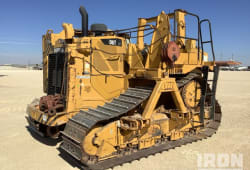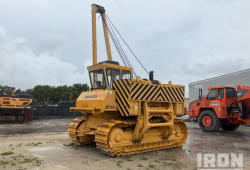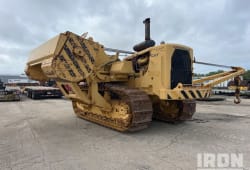Pipelayers in Construction: An In-Depth Discovery
9 Lectura mínima
)
diciembre 23, 2023
In the vast landscape of the construction industry, pipelayers play a pivotal role in the installation of underground utilities and pipelines. This specialized heavy equipment is designed to handle the challenges associated with laying pipes efficiently and safely. With a unique set of features and capabilities, pipelayers contribute significantly to the seamless execution of construction projects. From their robust design to their precise functionality, pipelayers ensure the effective placement of pipelines, meeting the demands of diverse construction environments.
Understanding Pipelayers
Pipelayers, integral to modern construction, are specialized machines designed for the efficient installation of pipes, conduits, and cables below the ground. Understanding Pipelayers is crucial, as these robust vehicles play a pivotal role in laying vital infrastructure like water and sewer lines, along with supporting the expansion of telecommunication and electrical networks. With precise engineering, Pipelayers ensure the seamless integration of essential utilities, contributing to the development and sustainability of urban environments worldwide.
Components of a Pipelayer
Boom and Counterweight System:
The boom serves as a vital lifeline, facilitating the seamless lifting and precise placement of pipes. This intricate process demands not only strength but also equilibrium. Enter the Boom and Counterweight System, a sophisticated duo ensuring stability and balance. The boom shoulders the weighty responsibility of material handling, particularly crucial when navigating the challenges posed by substantial loads.
Turret or Rotating Bed:
The advanced design of modern pipelayers incorporates innovative features like a Turret or Rotating Bed. This enhancement allows the pipelayer to rotate, providing flexibility in positioning pipes accurately. The Turret or Rotating Bed feature is instrumental in optimizing efficiency and precision during pipeline construction, ensuring seamless alignment and installation. This innovative capability enhances the versatility of pipelayers, contributing to smoother operations and increased productivity in the dynamic field of pipeline construction.
Undercarriage:
Tracks or wheels provide mobility and stability on various terrains. The efficiency of these locomotion systems is crucial for smooth movement, whether it's a rugged off-road landscape or a paved urban environment. Additionally, the undercarriage plays a pivotal role in supporting and connecting these tracks or wheels to the vehicle's framework, ensuring structural integrity and weight distribution.
Operator's Cab:
The advanced excavator boasts cutting-edge features, including a powerful hydraulic system and a durable steel frame. Its robust design ensures optimal performance in various construction environments. The Operator's Cab is a highlight, equipped with controls for precise operation and visibility for the operator. This thoughtful design enhances efficiency and safety, allowing operators to navigate and manipulate the machine with ease. Whether tackling excavation, grading, or other tasks, this excavator stands as a reliable and versatile solution for construction projects of any scale.
Types of Pipelayers
Crawler-Mounted Pipelayers
Overview:
Crawler-Mounted Pipelayers stand out with their robust capabilities. These specialized units excel in pipeline construction, seamlessly combining lifting prowess with advanced mobility. Their secret lies in a tracked undercarriage, ensuring unparalleled stability even in challenging terrains like muddy or uneven surfaces.
Applications:
Crawler-mounted pipelayers are indispensable in construction, effortlessly maneuvering challenging terrains with precision. These robust machines efficiently lift and place pipes, enhancing productivity on diverse projects. Commonly used in large-scale pipeline projects where stability is crucial.
Wheeled Pipelayers
Overview:
Wheeled pipelayers are versatile construction machines designed for enhanced mobility on smoother terrains. These specialized vehicles feature wheels, providing increased maneuverability, making them particularly well-suited for urban construction projects and areas with established infrastructure.
Applications:
Wheeled pipelayers are versatile machines designed for efficient pipe installation. These specialized vehicles excel in Wheeled Pipelayers Applications, frequently employed in projects requiring quick relocation and maneuverability. Their robust design and advanced features make them essential for navigating diverse terrains, ensuring precise pipe placement while optimizing productivity in dynamic construction environments.
Sideboom Pipelayers
Overview:
Sideboom Pipelayers are specialized machines designed for efficient pipe installation. These versatile units excel in navigating tight spaces and working near existing structures, thanks to a unique side-mounted boom. This distinctive feature allows pipes to be laid to the side of the machine, optimizing flexibility and precision in challenging environments.
Applications:
Sideboom Pipelayers find versatile applications in various industries, offering efficient solutions for pipeline installation and maintenance. These specialized machines excel in challenging terrains, ensuring precise and swift pipe placement. Commonly used in urban areas where space constraints are a challenge.
Operating a Pipelayer
Training and Certification
Operator Training:
Specialized training programs, including Operator Training, play a pivotal role in ensuring operators achieve proficiency in handling pipelayers. These programs emphasize rigorous instruction on safety protocols, mastery of equipment controls, and precision in pipe placement.
Certification:
In modern industries, operators play a pivotal role in ensuring seamless processes. These skilled professionals possess the expertise to manage complex systems efficiently. However, in recognition of the critical nature of their responsibilities, operators often need certification to demonstrate competence and adherence to industry standards.
Safety Considerations
Load Capacity:
Understanding and adhering to the pipelayer's load capacity is crucial for preventing accidents. Safety protocols must be followed diligently to ensure the equipment operates within its designated limits.
Terrain Assessment:
Operators must assess the terrain to ensure stability and prevent tip-overs. Proper terrain assessment is crucial for safe operations, guiding decisions that protect equipment, personnel, and overall mission success.
Communication:
In any aviation setting, efficient communication is paramount. Clear communication between ground personnel and the operator is vital for safe operations, ensuring seamless coordination and minimizing the risk of errors.
Applications of Pipelayers
Pipeline Construction
Mainline Pipelines:
Pipelayers play a crucial role in installing Mainline Pipelines, facilitating the transportation of oil, gas, or water across extensive distances. Their expertise is vital for seamless infrastructure development and operation.
Distribution Pipelines:
In urban and suburban areas, distribution pipelines are crucial infrastructure components, used to lay smaller pipelines for local distribution networks, ensuring efficient transportation and delivery of essential resources to communities.
Utility Installations
Water and Sewer Lines:
Pipelayers play a crucial role in urban development, specializing in the installation of infrastructure like water and sewer lines. Their expertise ensures the efficient distribution of water and reliable wastewater removal, enhancing community infrastructure.
Telecommunications and Electrical Infrastructure:
In urban landscapes, the intricate dance of progress unfolds through the relentless expansion of skyscrapers and bustling streets. Amid this evolution, telecommunications and electrical infrastructure play a pivotal role, used in the installation of underground conduits for telecommunications cables and electrical lines.
Advancements in Pipelayer Technology
GPS and Telematics Integration
Precision in Operation:
With precision in operation, our cutting-edge technology integrates seamlessly with GPS, ensuring accurate pipe positioning, minimizing errors, and maximizing operational efficiency for unparalleled results in every project.
Remote Monitoring:
Telematics revolutionize industries by integrating technology into operations. Remote monitoring of pipelayer performance through telematics ensures proactive maintenance, minimizing downtime for increased efficiency and reliability.
Automation and Robotics
Automated Pipe Handling:
Advancements in automation enable pipelayers to handle pipes with increased efficiency, reducing the need for manual intervention. Automated Pipe Handling streamlines operations, enhancing productivity and safety on construction sites.
Safety Enhancements:
Automated safety features contribute to accident prevention, such as collision avoidance systems. These safety enhancements prioritize passenger well-being, ensuring a secure and protected driving experience.
Challenges in Pipe Laying
Environmental Considerations
Trenchless Technology:
Modern construction prioritizes sustainability and efficiency. Trenchless Technology is gaining prominence, emphasizing methods that minimize environmental impact and disruptions to existing infrastructure, ensuring a more resilient and eco-friendly future.
Erosion Control:
During and after pipe laying projects, implementing effective erosion control strategies is crucial to mitigate environmental impact. These measures ensure sustainable development and protect ecosystems.
Regulatory Compliance
Permitting and Approval Processes:
In the intricate realm of pipelaying, meticulous planning is essential. This involves navigating through complex landscapes, adhering to safety standards, and streamlining Permitting and Approval Processes.
Environmental Impact Assessments:
Conducting assessments to gauge the potential environmental impact of pipelaying activities is crucial. Environmental Impact Assessments guide responsible decision-making, ensuring sustainable practices and minimizing ecological harm.
Future Trends in Pipe Laying
Sustainability
Green Pipe Laying Practices:
The construction industry is evolving with innovative practices like Green Pipe Laying Practices. Integration of sustainable methods includes recyclable materials and energy-efficient technologies for a more eco-friendly infrastructure.
Reducing Carbon Footprint:
In the pursuit of sustainable practices, innovations in pipe laying go beyond traditional methods. Engineers now explore alternative fuels and technologies, aiming to reduce the environmental impact and carbon footprint.
Integration of Artificial Intelligence
Predictive Maintenance:
Leveraging AI, our advanced systems streamline operations, enhance efficiency, and reduce costs. Predictive maintenance ensures optimal performance, minimizing downtime for sustained productivity and reliability.
Smart Construction Sites:
Smart Construction Sites leverage AI for enhanced decision-making and project management. This integration ensures efficiency, safety, and optimal resource utilization in the dynamic construction environment.
Conclusion
Pipelayers are indispensable assets in the construction industry, contributing to the development of vital infrastructure. As technology continues to advance, the role of pipelayers evolves, emphasizing efficiency, safety, and environmental responsibility. With ongoing innovations, pipelaying processes are poised to become more sustainable, automated, and aligned with the demands of a rapidly changing construction landscape. The future of pipelaying holds promise for enhanced performance and sustainability, ensuring the continued progress of crucial infrastructure projects with heightened efficiency and reduced environmental impact.

Rex Walz is Boom & Bucket's Manager of Supplier Relations, bringing over a decade of experience in B2B sales and heavy equipment solutions. With a background spanning government, construction, industrial, and commercial sectors, he has a proven track record of driving growth and building trusted customer relationships. At Boom & Bucket, Rex is passionate about helping partners succeed while advancing the company's mission to create the most trusted marketplace for heavy equipment.














